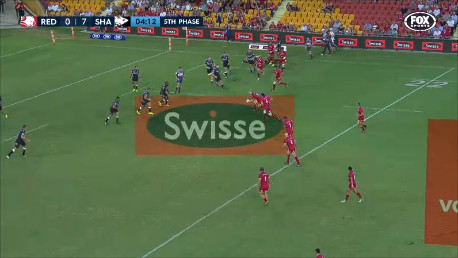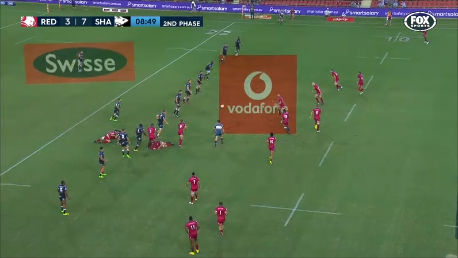It wasn’t perfect. There was a distinctly early-season feel to the Reds’ win over the Sharks, with many a dropped pass and breakdown in understanding.
But, given that the Sharks travel better than any other South African franchise, ultimately it was a victory with rather more pricks than kicks for the Reds’ new coaching group.
There were several embryonic signs of the potential that has been pulled together via an impressive off-season recruitment drive by the Queensland franchise – from the vigour of young forwards like Adam Korczyk and Izack Rodda, through to the mature leadership influence of veterans like George Smith and Quade Cooper in the middle five of the team, and on towards the exciting midfield promise of Cooper, Duncan Paia’aua and Karmichael Hunt in the distribution corps.
There were also one or two warning signs, particularly associated with the use of Cooper from defensive set-pieces.
One of the key issues with the Reds in last year’s competition was the lack of adaptation shown, especially with ball in hand, when circumstances did not turn out as they had planned.
This season’s group already look to be able to reverse that particular trend and improvise solutions on the field.
At the beginning of the game, the plan looked to be spread the field with a formation not dissimilar to the attacking pattern employed by the Wallabies.
No.7 George Smith found himself in the Michael Hooper role in the wide 15 metre zone:


You can just about see Smith’s head bobbing above the bottom of the frame at 4:12 with the two Wallaby-style forward pods infield, while at 8:49 he is stationed along with a front-rower and No.11 Eto Nabuli in the left-hand 15-5m area.
With the Sharks often adopting a 13 or 14-man defensive line and having men spare to blitz up on the ball, the Reds’ on-field leadership understood by the end of the first quarter that a policy of spreading the ball wide immediately was an invitation to disaster.
As a result, George Smith’s positioning on attack changed and he moved into midfield, in between the two 15 metre lines. At the current stage of his career, this is a function that suits him far better in any case – especially as the Reds have another back-rower well capable of handling the outside role in the form of their No.8 Scott Higginbotham.
The following reel illustrates some of the successes the Reds achieved with this change of attacking policy.
In the first clip, at 16:07 Smith has squeezed the space to play much closer to the second Reds’ forward pod, composed of Korczyk, Rob Simmons and James Slipper – to the point where he is actually playing at midfield rather than on the left 15m line.
This creates a two-second ruck ball that in turn allows Cooper, Paia’aua and Hunt to connect promisingly out wide, even though Hunt eventually drops the ball in the half-gap.
In the second example, he is involved twice – above the ruck on cleanout duty at 17:23 and picking up at the base ten seconds later at 17:33.
The second ruck delivery is just about quick enough to enable Cooper to play flat on the next phase and give the second man attack through Karmichael Hunt some real punch.
Note that is Higginbotham now playing in the ‘wide three’ out to the left, rather than Smith.
The more Smith engaged in midfield, the better things got for the Reds on attack. At 47:02 he is able to break right up through the guts with the Sharks’ guard defence not set, at 20:17 he is outside Quade Cooper, drawing enough attention away from the in-pass option (Hunt again) to make that play work for a clean break and another scoring opportunity.
It was not glamorous work but it was just what was required against the Sharks’ outside pressure on defence, pressure which had already earned the first try of the game in the 2nd minute (see end clip, with Smith once again marooned out on the left 5m line).
This is what on-field leadership means – making small adjustments to a plan that is not working, so that your game again becomes functional and you step ahead of the opponent in the tactical ‘game of chess’.
The Reds’ tries were also built on the same foundation.
The Reds’ first try in the 33rd minute, comes from a left-side scrum similar to the position from which Wales scored a try against England.
In fact, the whole set-up looks very familiar, with George Smith and Nick Frisby drifting over to the short-side to pull the Sharks’ No.14 back over in that direction (he starts underneath the No.10) and blind-side wing Nabuli looming threateningly in midfield.
But the Reds stick to what they know works against the Sharks D. Samu Kerevi takes the ball on the hard ‘unders’ line on 1st phase (the decoy line in the England versus Wales match), Simmons and Smith pick and go up the guts on the following two phases, getting close enough for Scott Higginbotham to press the ball cleverly against the bottom of a post pad and make the score.
The second try, also from a red zone scrum, again has Kerevi doing the hard donkey-work, straightening nose down through two Sharks back-line defenders to force himself over the whitewash.
The second example from the reel at 62:18 shows Smith again initially involved in the cleanout in midfield and allowing the Cooper/Hunt combination to spring Higginbotham free in his the wide role down the left tram-lines.
Smith is back up and in midfield action, carrying and offloading at 62:34 before Kerevi eventually scores his second try of the match at 63:04 on the ninth phase in the sequence.
At the same time, there were one or two glimpses of suspect tactical choices which may cost the Reds’ dearly against better opponents.
The deployment of Quade Cooper at full-back from defensive set-pieces (with Hunt up in the line in the 10 channel) is surely an experiment whose time has come and gone.
At the end of the Reds tactics reel, we can see Cooper defending at 15 from both scrum (11:35) and lineout (41:48).
I voiced my doubts about this policy in an article on the 2016 Rugby Championship and I’m still doubtful whether it will survive the fixtures against the Crusaders in round three and the Lions in round four.
Despite the early-season feel of the Reds-Sharks encounter, it touched on many issues both recent and relevant in the game as a whole.
Take a look at the Reds’ rucks in the tactics reel at 16:14, 16:19 and 17:24. With events in the England-Italy in view, has any true ruck (with an opponent still on his feet) been formed in these instances? What is to stop the Sharks’ defenders playing from the Reds’ side of the breakdown before the ball emerges?
Are we going to see Quade still defending at full-back in the stiffer tests to come? Is this really a viable defensive solution long-term (for the Reds and beyond)?
Can anyone be in doubt about the value of experienced on-field leadership after watching the Reds’ attacking adjustments in the course of the Sharks game?
Whether the change came from George Smith or Quade Cooper or Scott Higginbotham or a combination of all three, they saw a direction in which the game was going and they did something concrete to reverse the momentum, changing the attacking pattern to suit the circumstances. It won them the game.































































































